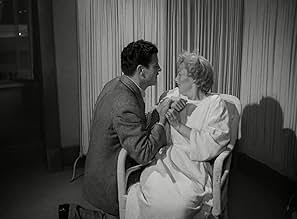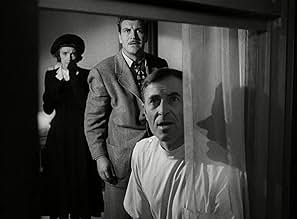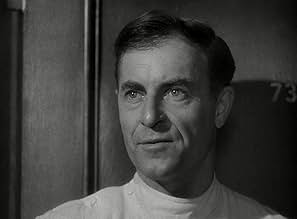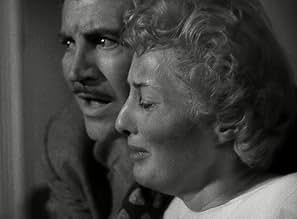IMDb रेटिंग
6.6/10
1.2 हज़ार
आपकी रेटिंग
अपनी भाषा में प्लॉट जोड़ेंA desperate husband tries to find help for his wife suffering from addictive gambling.A desperate husband tries to find help for his wife suffering from addictive gambling.A desperate husband tries to find help for his wife suffering from addictive gambling.
- पुरस्कार
- कुल 3 जीत
Philip Van Zandt
- Chuck
- (as Phil Van Zandt)
Tony Curtis
- Bellboy
- (as Anthony Curtis)
Peter Leeds
- Jack Harrison - Hotel Clerk
- (as Peter Lewis)
फ़ीचर्ड समीक्षाएं
Barbara Stanwyck is surely one of the greatest actresses ever in motion pictures but THE LADY GAMBLES is one of her lesser works despite a sincere, empathic performance by the star. This movie seems to want to be the gambling version of THE LOST WEEKEND but it's more like the lost 100 minutes , the time the viewer wastes watching this picture. Even the charismatic Stanwyck can't prevent this heavy-handed drama from being a chore to watch.
Stanwyck stars as the wife of newspaper journalist Robert Preston. They are in Las Vegas while he covers a story. Stanwyck decides to try to do an article herself on the gambling scene but her somewhat indiscreet camera work catches the eye of casino manager Stephen McNally who decides to let her play with valueless chips so she can be at the tables for her research. Trouble is Stanwyck finds she likes the tables a little too much and when McNally decides to put a plug in the playing for nothing, she dives into Preston's expense account and loses it all in a night. McNally, clearly attracted to Stanwyck from first sight, gives her $50 to play with out of pity after she has even hawked her expensive Swiss camera and being the good player she is Stanwyck actually wins her money back. But the lure of the tables is too strong and she keeps going back. And back. And losing. Ultimately destroying her marriage, she eventually joins forces with McNally in some of his questionably legal activities and later hits earthier lows in pursuit of lady luck where one seedy guy after another tells her to "kiss 'em for me baby" as she rolls the dice.
The movie is told in flashback as Stanwyck is hospitalized having been beat up by gamblers when she is caught dealing in a back alley crap game with loaded dice. Estranged husband Preston rushes to her side and tells the doctor the whole sad story.
The usually dependable Preston is one of the weakest links in the film; his character is alternately a milquetoast and a control freak but is at all times presented as Stanwyck's prince charming. Preston's performance is no help either, his rather theatrical delivery seems inappropriate for this attempt at "slice of life" drama; worse, in an amazingly unwise decision he speaks to the doctor in anguished troubled tones and then his narration over the past scenes is spoken with enthusiasm and dramatic flair! Stephen McNally fares much better as the intimidating Vegas big shot, his scenes with Stanwyck have considerable bite and are the film's highlight.
The worst thing about the film is the jaw-dropping pop psychology that attempts to explain away Stanwyck's gambling. It's because of her possessive older sister Edith Barrett!!! With her mother dying during childbirth, Stanwyck was "raised" by older (eight years, although Barrett was actually just six months older than Stanwyck) sister who has never let Barbara forget the sacrifices in her personal life she has made for her. Hero Preston seems frankly as controlling but since he is her husband, presumably that's OK with the screenwriters. The sister-is-the-root theory is interesting considering (A) Preston is hostile to the sister and her relationship with Barbara long before the gambling starts, (B) the gambling doesn't even start until Stanwyck is clearly into her thirties and (C) the sister is no where around to cause anxiety when most of the gambling binges occur!! But then what can you expect of reason from a film where a doctor attempts reverse psychology, encouraging a patient on a building ledge to jump!!
Barbara Stanwyck is always worth watching, her progression from dabbler to desperate is quite credible but even her solid work here can't save a movie that plays like a 1940's version of a 1970's half-baked "social issue" TV movie. Two stars going in opposite directions are also in the cast: newcomer Tony Curtis has an early bit part as a bellhop and 30's leading man Leif Erickson can be seen in a small role as one of McNally's questionable cohorts. Is this picture worth checking out? Well, it's your gamble.
Stanwyck stars as the wife of newspaper journalist Robert Preston. They are in Las Vegas while he covers a story. Stanwyck decides to try to do an article herself on the gambling scene but her somewhat indiscreet camera work catches the eye of casino manager Stephen McNally who decides to let her play with valueless chips so she can be at the tables for her research. Trouble is Stanwyck finds she likes the tables a little too much and when McNally decides to put a plug in the playing for nothing, she dives into Preston's expense account and loses it all in a night. McNally, clearly attracted to Stanwyck from first sight, gives her $50 to play with out of pity after she has even hawked her expensive Swiss camera and being the good player she is Stanwyck actually wins her money back. But the lure of the tables is too strong and she keeps going back. And back. And losing. Ultimately destroying her marriage, she eventually joins forces with McNally in some of his questionably legal activities and later hits earthier lows in pursuit of lady luck where one seedy guy after another tells her to "kiss 'em for me baby" as she rolls the dice.
The movie is told in flashback as Stanwyck is hospitalized having been beat up by gamblers when she is caught dealing in a back alley crap game with loaded dice. Estranged husband Preston rushes to her side and tells the doctor the whole sad story.
The usually dependable Preston is one of the weakest links in the film; his character is alternately a milquetoast and a control freak but is at all times presented as Stanwyck's prince charming. Preston's performance is no help either, his rather theatrical delivery seems inappropriate for this attempt at "slice of life" drama; worse, in an amazingly unwise decision he speaks to the doctor in anguished troubled tones and then his narration over the past scenes is spoken with enthusiasm and dramatic flair! Stephen McNally fares much better as the intimidating Vegas big shot, his scenes with Stanwyck have considerable bite and are the film's highlight.
The worst thing about the film is the jaw-dropping pop psychology that attempts to explain away Stanwyck's gambling. It's because of her possessive older sister Edith Barrett!!! With her mother dying during childbirth, Stanwyck was "raised" by older (eight years, although Barrett was actually just six months older than Stanwyck) sister who has never let Barbara forget the sacrifices in her personal life she has made for her. Hero Preston seems frankly as controlling but since he is her husband, presumably that's OK with the screenwriters. The sister-is-the-root theory is interesting considering (A) Preston is hostile to the sister and her relationship with Barbara long before the gambling starts, (B) the gambling doesn't even start until Stanwyck is clearly into her thirties and (C) the sister is no where around to cause anxiety when most of the gambling binges occur!! But then what can you expect of reason from a film where a doctor attempts reverse psychology, encouraging a patient on a building ledge to jump!!
Barbara Stanwyck is always worth watching, her progression from dabbler to desperate is quite credible but even her solid work here can't save a movie that plays like a 1940's version of a 1970's half-baked "social issue" TV movie. Two stars going in opposite directions are also in the cast: newcomer Tony Curtis has an early bit part as a bellhop and 30's leading man Leif Erickson can be seen in a small role as one of McNally's questionable cohorts. Is this picture worth checking out? Well, it's your gamble.
Despite some of the reviews here that characterize TLG as trite and dated, I only thought this film was a directorial surprise, way ahead of its time for 1949.
First you start with a flashback by Preston's character that isn't quite a flashback, because we are more interested in who this man is and what the circumstances of his plight are, than the past per se. Virtually all Hollywood flashbacks seem to involve some grand police confession or some need to explain the confessor (such as "D.O.A.")but the flashback here seems to add to the convolutedness of the characters, and the surrealism of the situation. Does Preston really understand his wife? If so when? The flashback reminds us that there is more to explain than the "what",but also the "why" which neither Preston nor the audience yet understand (gambling is a disease, but the matter of guilt and personal responsibility for misdeeds remain open).
More convolutedness in the photography. Carefully cropped chest-up body shots, with swirling camera movements amid authentic but claustrophobic interiors. Remember, only Max Ophuls was supposed to have done this sort of thing at the time! I remember "Leaving Las Vegas" attempted the same themes in slightly different ways (misery and anomie in a spectacular setting) but that was a miserable film.
Finally you have a not so sweet resolution to depict insanity, but in a much subtler way than "The Snake Pit" and other entries in the growing body of 'social consciousness' films. Stanwyck was a tough-soft actress, and the scenes where she rolls before a throng a gamblers rarely came tougher in her films. A work to just watch.
First you start with a flashback by Preston's character that isn't quite a flashback, because we are more interested in who this man is and what the circumstances of his plight are, than the past per se. Virtually all Hollywood flashbacks seem to involve some grand police confession or some need to explain the confessor (such as "D.O.A.")but the flashback here seems to add to the convolutedness of the characters, and the surrealism of the situation. Does Preston really understand his wife? If so when? The flashback reminds us that there is more to explain than the "what",but also the "why" which neither Preston nor the audience yet understand (gambling is a disease, but the matter of guilt and personal responsibility for misdeeds remain open).
More convolutedness in the photography. Carefully cropped chest-up body shots, with swirling camera movements amid authentic but claustrophobic interiors. Remember, only Max Ophuls was supposed to have done this sort of thing at the time! I remember "Leaving Las Vegas" attempted the same themes in slightly different ways (misery and anomie in a spectacular setting) but that was a miserable film.
Finally you have a not so sweet resolution to depict insanity, but in a much subtler way than "The Snake Pit" and other entries in the growing body of 'social consciousness' films. Stanwyck was a tough-soft actress, and the scenes where she rolls before a throng a gamblers rarely came tougher in her films. A work to just watch.
This is one of the best films about the madness of gambling. As a former compulsive gambler, I can really relate to this film. The only other film about gambling addiction that could be better is The Great Sinner starring Gregory Peck. I don't like to tell the plot on my reviews, and I won't now either. Barbara Stanwyk does an incredible job as a woman that gets obsessed gambling. When she describes how it's a "good tired" after a night of gambling( after she wins) and how Stephen McNally describes the good tired even after you lose. Both logics are so true. Stanwyks performance is brilliant as a lunatic gambler. If you're a gambler or an ex over the top gambler, you'll enjoy this film.
It is very evident that Barbara Stanwyck was able to adapt to any sort of role or character in each of her pictures. In this one, she plays a businessman's wife who becomes addicted to gambling after a trip to Las Vegas. This isn't a bad character study, and probably one of the earliest ones dealing with this sort of obsession. It is also interesting to see how the Vegas strip looked in over 50 years ago. A young, unknown Tony Curtis has a cameo as a bell boy.
From 1949, The Lady Gambles stars Barbara Stanwyck, Robert Preston, and Stephen McNally.
Stanwyck plays Joan Boothe, who accompanies reporter husband David (Preston) to Las Vegas where he is working on a story about the Hoover Dam. Left to her own devices, she becomes interested in gambling to the point where it becomes an addiction. Though she tries to fight it, she can't, and ultimately loses her husband and falls into the clutches of Horace Corrigan, who runs the casino and has her number.
Stanwyck does well showing Joan's downward spiral. The film dabbles in psychology in Joan's relationship with her older sister Ruth (Edith Barrett) for whom she takes responsibility, though her husband objects.
Good performances all around, as well as some brutal and scary moments. Definitely keeps your interest.
Watch for Tony Curtis in one of his first speaking roles as a telegram delivery boy. The director told him, "All you want is a tip." He's adorable.
Stanwyck plays Joan Boothe, who accompanies reporter husband David (Preston) to Las Vegas where he is working on a story about the Hoover Dam. Left to her own devices, she becomes interested in gambling to the point where it becomes an addiction. Though she tries to fight it, she can't, and ultimately loses her husband and falls into the clutches of Horace Corrigan, who runs the casino and has her number.
Stanwyck does well showing Joan's downward spiral. The film dabbles in psychology in Joan's relationship with her older sister Ruth (Edith Barrett) for whom she takes responsibility, though her husband objects.
Good performances all around, as well as some brutal and scary moments. Definitely keeps your interest.
Watch for Tony Curtis in one of his first speaking roles as a telegram delivery boy. The director told him, "All you want is a tip." He's adorable.
क्या आपको पता है
- ट्रिवियाThe scene where Corrigan (Steven McNally) tells the girls "No-one uses my first name....because it's Horace" could well have been an in-joke as Stephen McNally's birth name was Horace Vincent McNally.
- गूफ़Reflected in the bus window that Joan is on.
- भाव
Joan Phillips Boothe: May I come in?
Barky: Ask a foolish question, and you get a foolish answer.
टॉप पसंद
रेटिंग देने के लिए साइन-इन करें और वैयक्तिकृत सुझावों के लिए वॉचलिस्ट करें
- How long is The Lady Gambles?Alexa द्वारा संचालित
विवरण
- रिलीज़ की तारीख़
- कंट्री ऑफ़ ओरिजिन
- भाषाएं
- इस रूप में भी जाना जाता है
- Gambling Lady
- फ़िल्माने की जगहें
- उत्पादन कंपनी
- IMDbPro पर और कंपनी क्रेडिट देखें
- चलने की अवधि
- 1 घं 39 मि(99 min)
- रंग
- पक्ष अनुपात
- 1.37 : 1
इस पेज में योगदान दें
किसी बदलाव का सुझाव दें या अनुपलब्ध कॉन्टेंट जोड़ें























